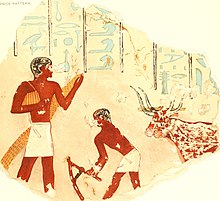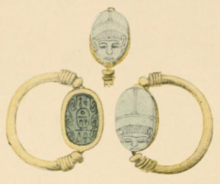Percy Newberry
Percy Edward Newberry | |
|---|---|
| Born | 23 April 1869 Egyptologist |
Percy Edward Newberry
Biography

Percy Newberry was born in Islington, London on 23 April 1869. His parents were Caroline (née Wyatt) and Henry James Newberry, a woollen warehouseman. Newberry developed a strong attachment to botany in childhood and was also an excellent artist. He studied at King's College School and King's College London, and studied botany at Kew Gardens.[1]
Career
In 1884, on the invitation of Reginald Stuart Poole, Newberry began administrative work at the Egypt Exploration Fund, founded just two years previously. Here he met a number of established Egyptologists, including Flinders Petrie, Amelia Edwards and F. L. Griffith, who acted as his mentor. He continued in this role until 1886, when he began his own research in Egyptology, presenting a paper on botany in excavations to the British Association in 1888, with Petrie making use of Newberry's botanical expertise to identify botanical remains found during past excavations.[1]
In 1890 Newberry travelled to Egypt with
On the strength of his fieldwork and publications, Newberry was appointed the first
Newberry supported the Tutankhamun excavation team for several seasons, and was present on 12 February 1924 when the king's sarcophagus was opened.[4] His speciality was the botanical specimens from the tomb, on which he would briefly report in the second volume of Carter's The Tomb of Tut.ankh.Amen, published in 1927.[2]
In 1927–28 Newberry explored the
Personal life
On 12 February 1907 Newberry married Essie Winifred Johnston (1878–1953). They had no children. He died on 7 August 1949 at his home in Godalming in Surrey aged 80.[1]
Works

Newberry wrote extensively on Egyptology, including reports on archaeological findings and numerous contributions to English, French, and German scientific journals.
- Beni Hasan. London: Kegan Paul, Trench, Trübner & Co. 1893.
- El Bersheh. Archaeological survey of Egypt, 3rd memoir. London: Egypt Exploration Fund. 1895.
- The life of Rekhmara. Westminster: Archibald Constable. 1900.
- A short history of ancient Egypt. London: Archibald Constable. 1904. (with John Garstang)
- Scarabs: an introduction to the study of Egyptian seals and signet rings. London: Archibald Constable. 1906.[6]
- Scarab-shaped seals. Catalogue général des antiquités égyptiennes du Musée du Caire, v. 32. London: A. Constable and Co. 1907.
- The Timins collection of ancient Egyptian scarabs and cylinder seals. London: Archibald Constable. 1907.
- 'Egypt as a Field of Anthropological Research' in British Association for the Advancement of Science, Report of the Ninety-first Meeting, Liverpool 1923 : Sectional Presidential Addresses, H (London: Murray, 1924).
- Egypt as a field for anthropological research. Washington. 1925.
{{cite book}}: CS1 maint: location missing publisher (link) - Funerary statuettes and model sarcophagi. Catalogue général des antiquités égyptiennes du Musée du Caire. Cairo (Le Caire): Institut français d'archéologie orientale. 1930.
References
- ^ ISBN 019861411X.
- ^ ISBN 0-7136-2131-1.
- ^ OCLC 470552591.
- OCLC 828501310..
- ^ "No. 31840". The London Gazette (Supplement). 26 March 1920. p. 3798.
- ^ "Review of "Scarabs. An Introduction to the Study of Egyptian Seals and Signet Rings." by Percy E. Newberry". Journal of the Royal Asiatic Society of Great Britain and Ireland: 511–513. April 1906.
External links
- "Percy Newberry, Egyptologist, Dies". The New York Times. 8 August 1949. Retrieved 28 February 2009.
- "Faculty of Asian & Middle Eastern Studies: Percy Edward Newberrry (1868-1949), Egyptologist". University of Cambridge. Archived from the original on 7 July 2014. Retrieved 11 May 2014.
